You'll need anti-static bags and ESD-safe packaging materials to protect your computer components from damaging electrostatic discharge. Shielding bags with metalized film provide the best protection by creating a Faraday cage effect, while conductive foams and anti-static bubble wrap offer additional safeguarding during shipping. For ideal protection, store components in these materials and always ground yourself before handling them. Maintain humidity levels above 40% to reduce static buildup, and avoid static-prone clothing when working with sensitive electronics. Following proper ESD protection standards can save you from costly component failures and replacements down the line.
Understanding ESD Packaging Basics
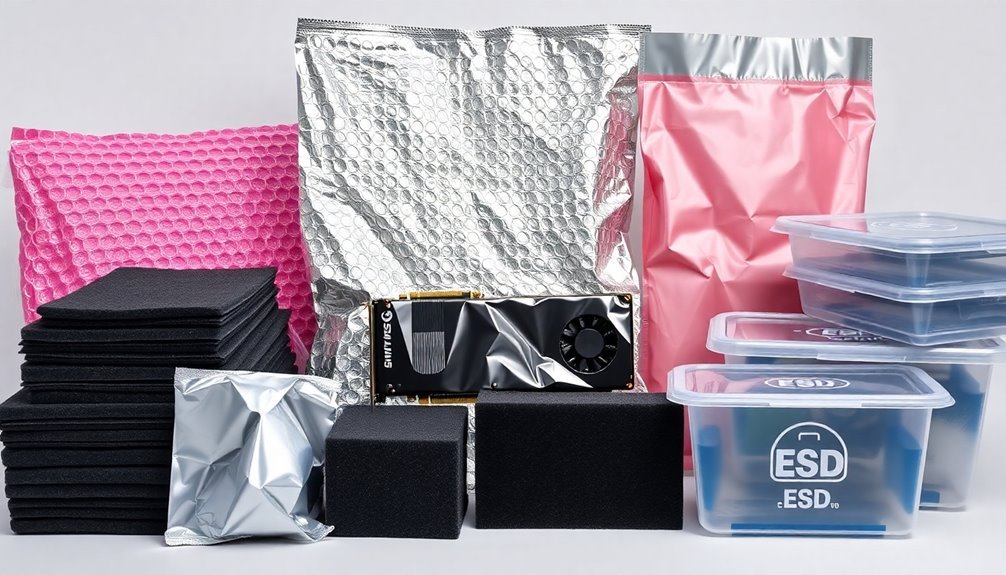
If you work with electronic components, you'll need to understand how ESD (Electrostatic Discharge) packaging protects sensitive devices during shipping and handling. The packaging works by resisting charge buildup and preventing electrical charges from entering or exiting the container. When a charge contacts the packaging, it flows around the surface instead of creating potentially damaging sparks.
ESD packaging creates what's known as a Faraday cage around your components. This protective barrier, typically made from aluminum and treated plastic, disperses electromagnetic charges safely away from sensitive items. You'll find that Faraday bags are particularly effective at shielding electronic components from harmful static electricity. Maintaining humidity above 40% in storage areas helps reduce the potential for static voltage buildup. The growth of the ESD packaging market to $2.4 billion demonstrates its critical importance in protecting electronic components.
You'll encounter various types of ESD packaging materials in computer component handling. These include anti-static stretch film, specialized plastic bags, shielding bags, and protective bubble wrap. Each type serves specific purposes, with some offering additional protection against moisture and vibration.
Conductive materials within the packaging help remove energy from the components inside, ensuring they remain safe throughout transit. When selecting ESD packaging, you'll want to match the protection level to your components' sensitivity while following industry guidelines like EN 61340-5-2.
Common ESD Protection Materials
When you're protecting computer components, you'll need to rely on specialized ESD packaging materials like shielding bags that block external charges from reaching sensitive parts.
Anti-static films and coatings work by preventing the buildup of damaging static electricity on packaging surfaces that come into contact with your components. Since human perception begins at around 3000V, many damaging ESD events can occur without detection.
Conductive materials, including specially treated plastics and foams, create a protective barrier that safely guides charges away from vulnerable electronic parts. With modern CMOS devices operating at very low voltages, proper ESD packaging becomes especially critical to prevent permanent damage.
Shielding Bags Block Charges
Three key features make shielding bags an essential ESD protection solution. First, they're constructed with metalized film and treated plastic, creating a robust barrier against electromagnetic charges.
Second, they function as Faraday cages, dispersing harmful static charges along their exterior surface rather than allowing them to reach your sensitive components.
Third, they're designed to be completely sealable, ensuring no electrostatic charges can enter or exit once your electronics are secured inside.
You'll find shielding bags particularly effective when you need to protect computer components during shipping and storage. The bags' unique construction combines aluminum with specially treated plastic, offering superior protection against electrostatic discharge events that could otherwise damage your electronics. The inclusion of special additives during manufacturing reduces surface resistance and enhances conductivity. Using proper ESD packaging is especially crucial for hard drives since they are highly dust-sensitive components.
When you're handling items like motherboards, RAM, or processors, these bags provide reliable ESD protection that meets industry standards.
If you're working with various component sizes, you'll appreciate that shielding bags come in multiple configurations to accommodate your specific needs.
They're durable enough to withstand shipping and handling while maintaining their protective properties, ensuring your components arrive safely and function properly upon installation.
Anti-Static Films Prevent Damage
Anti-static films' versatile protection makes them an indispensable choice for safeguarding electronic components. You'll find various types available, including ESD PET film, static dissipative film, and anti-static polyimide film, each designed to prevent static charge build-up and protect sensitive electronics during handling, storage, and shipping. The acrylic or silicone coating ensures optimal adhesion while maintaining protective properties.
These films offer multiple advantages you can't ignore. They eliminate static charges while providing excellent weather resistance and leaving no residue when removed. With surface resistivity typically ranging from 10^5 to 10^11 Ω, they effectively dissipate static electricity that could damage your components. You can choose from different thicknesses, such as 50µm or 100µm, depending on your specific needs. The rapid growth of the gaming industry has made these protective solutions increasingly vital for manufacturers.
You'll find these films particularly useful in electronics manufacturing, PCB protection, and silicon wafer handling. They're available in various colors (like pink for dissipative films) and can be transparent for easy content identification.
Whether you're packaging computer parts or protecting components during production, you can customize these films to your specifications. They'll save you money by preventing ESD damage and extending your electronic devices' lifespan.
Conductive Materials Guard Components
Conductive packaging materials form your first line of defense against electrostatic discharge in electronics protection. These specialized materials, including treated polypropylene and polyethylene, feature surface resistance levels of 10^4-6 Ω that effectively prevent static buildup.
You'll find these materials in various forms, from shielding bags to stretch films, all designed to protect your sensitive electronic components.
When you're handling components like RAM cards, CPUs, or motherboards, you'll want packaging that creates a Faraday cage effect. Metalized bags and conductive containers surround your components on all sides, blocking both static and electromagnetic charges.
These materials are particularly important for protecting MOSFET and CMOS devices, which are especially vulnerable to ESD damage due to their small geometries.
You'll save money in the long run by investing in proper conductive packaging. It's far more cost-effective to use ESD-safe containers than to replace damaged electronics.
The materials meet industry standards and regulations while providing essential protection during shipping and storage. For high-precision components like resistors and laser diodes, conductive packaging isn't just an option—it's a necessity for maintaining their integrity.
Proper Storage of Electronic Components
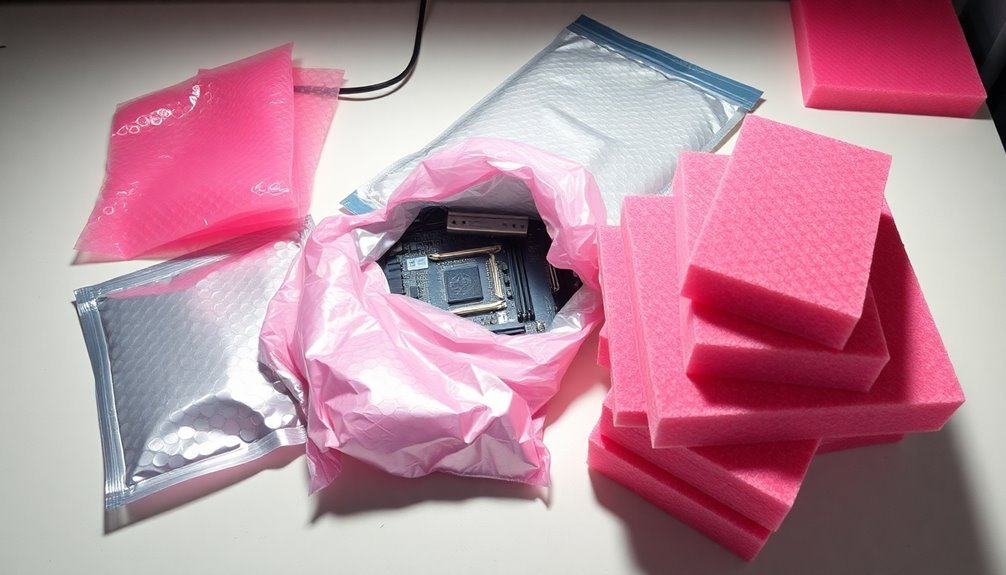
Storing electronic components properly can make the difference between their survival and failure. You'll need to keep your sensitive electronics in shielded containers that provide complete Faraday cage protection, ensuring charges can't enter or exit the packaging.
Always use anti-static bags for both new and removed components to maintain consistent ESD protection. Components should be stored on hard surfaces to prevent damage during storage. Sensitive parts like DIMMs require extra care when handling and storing.
Before handling any components, you'll want to ground yourself by touching a metal-grounded object to discharge static electricity from your body. Don't forget to disconnect all cables, remove batteries, and press the power button for 5 seconds to discharge residual power.
When working with components, use a grounding wrist strap, mat, or table to maintain zero potential.
Don't use damaged packaging, as it compromises the ESD protection your components need. Make sure all containers have proper lids and seals to maintain the Faraday cage effect on all sides.
You'll also want to minimize your movement while handling components, as this can generate unwanted static. Remember to wear non-static clothing and remove metal jewelry that could cause static buildup during component handling and storage.
Choosing the Right ESD Bags
With proper storage practices in place, you'll need to select the right ESD bags for your components. Choose from four main types: shielding bags with metalized film for maximum protection, antistatic bags for basic static reduction, conductive bags that remove energy, and dissipative bags that slow down electrical charges.
When selecting ESD bags, consider your component's sensitivity level and shipping conditions. You'll want bags that create a Faraday cage effect, using materials like aluminum or treated plastic to block static and electromagnetic charges. Verify the bags offer adequate moisture protection if you're shipping through humid environments.
Always pick bags that fit your components snugly, and seal them properly to maintain their protective properties. You'll need to ground yourself before handling components, and avoid damaging the bags during shipping and storage.
Consider cost-effectiveness, but don't compromise on protection – replacing damaged components will cost far more than quality ESD bags.
For additional protection, you can use ESD bubble wrap that combines physical cushioning with dissipative properties. Store your packed components in a clean, dry environment to maintain the bags' effectiveness and guarantee your electronics remain safe.
Static Control During Component Handling
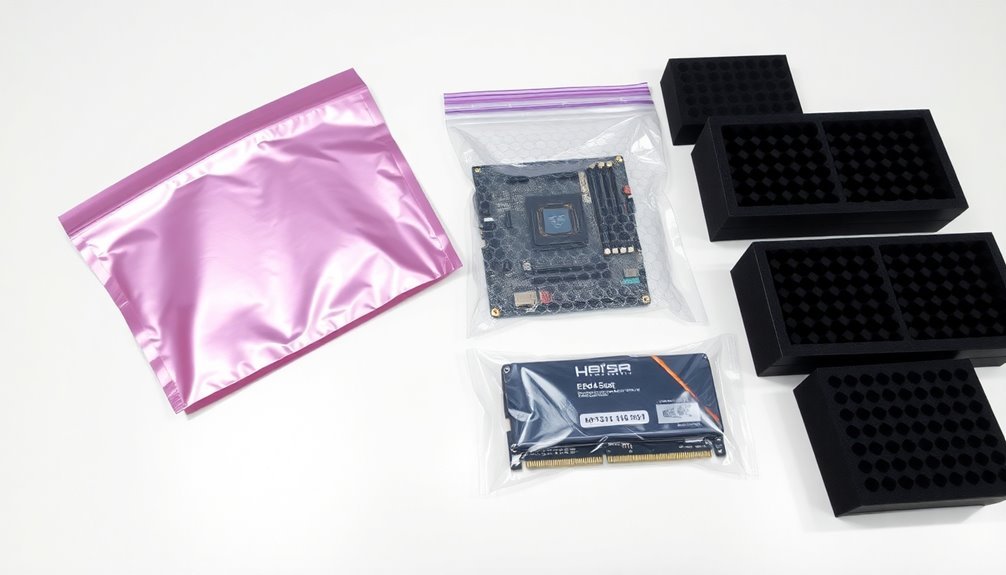
A single spark of static electricity can destroy sensitive electronic components in an instant. When you're handling computer parts like MOSFETs, CMOS devices, or high-precision components, you'll need to take proper precautions to prevent costly damage. These sensitive parts are particularly vulnerable due to their small geometries and thin protective layers.
Before you start working with any electronic components, make sure you've implemented these essential static control measures:
- Always wear a properly grounded wrist strap connected to an ESD mat or grounded work surface.
- Disconnect all power sources, including cables and batteries, before opening any electronic devices.
- Touch an unpainted metal surface to discharge static electricity from your body.
- Remove metal jewelry and avoid wearing static-prone clothing like wool or synthetic fabrics.
You'll want to gather all necessary tools before starting your work to minimize movement and static generation.
Remember that modern electronic components are becoming increasingly sensitive to ESD damage, so maintaining proper grounding throughout the handling process isn't optional – it's vital.
Using appropriate ESD-safe tools and maintaining a controlled work environment will help protect your valuable components from invisible but destructive static charges.
Damage Risks Without ESD Protection
Even with proper handling procedures in place, electronic components face significant risks when they're not protected by appropriate ESD packaging. MOSFET transistors and CMOS devices are particularly vulnerable to static discharge, especially in newer components with smaller geometries. Your high-precision resistors and laser diodes can fail instantly from a single static event.
During shipping and handling, you'll encounter multiple threats to your components. Static buildup occurs naturally through tribocharging when materials contact each other, and moisture in the environment can worsen this effect. If you're shipping exposed circuit boards without proper ESD protection, they're susceptible to damage from both electromagnetic interference and physical impacts that can trigger static discharges.
You'll need to understand that static-related damage isn't always immediately visible. A component might appear fine but fail prematurely due to weakened internal structures. That's why you can't rely on visual inspection alone – you must use appropriate ESD packaging from the start.
If you're using damaged or compromised packaging materials, you're fundamentally leaving your components exposed to these destructive forces. Regular inspection of your ESD packaging and proper grounding techniques are essential to maintain protection throughout the handling process.
ESD Standards for Computer Parts
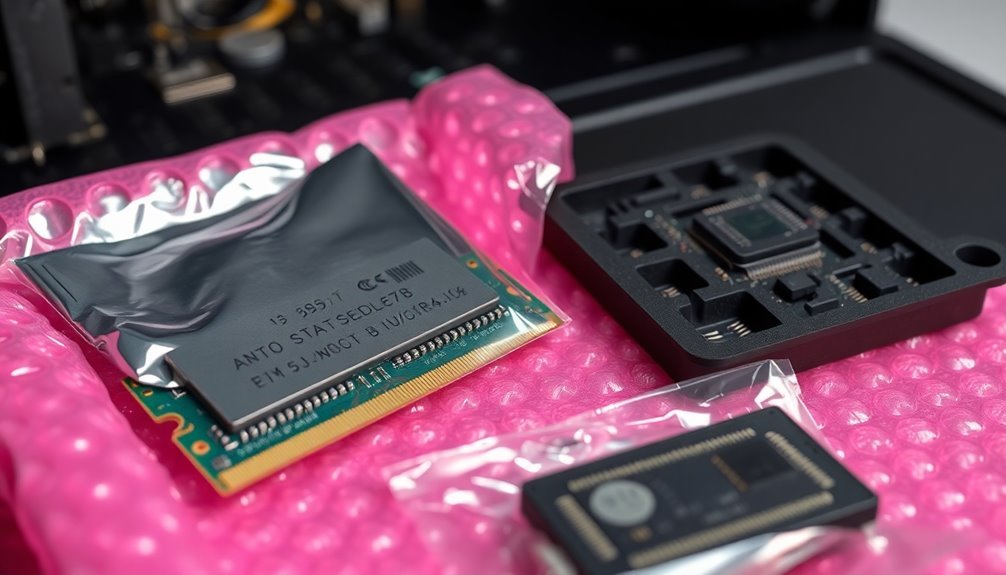
When you're handling computer components, you'll need to follow strict ESD standards like EN 61340-5-2 to guarantee proper protection during storage and transport.
You'll find that certification requirements vary by industry, with healthcare and aerospace demanding the most rigorous testing protocols for ESD packaging materials.
Testing methods typically include surface resistivity measurements, decay time analysis, and shielding effectiveness verification to maintain compliance with international standards.
Industry Certification Requirements
Computer component manufacturers must comply with several international ESD packaging standards to confirm their products remain protected during storage and transport. The most critical certification requirements come from the IEC 61340 series and ANSI/ESD S20.20, which establish thorough guidelines for ESD protection programs and control procedures.
Key certification requirements you'll need to know about:
- EN 61340-5-1 sets the baseline requirements for ESD protective packaging and demands specific performance criteria for materials.
- EN 61340-5-2 provides detailed guidance on selecting appropriate packaging solutions based on component sensitivity.
- IEC 61340-4-4 establishes the classification system for packaging materials based on their electrostatic properties.
- ISO 22574 defines how packaging materials should be classified regarding their ESD protection capabilities.
To meet these standards, manufacturers must use approved materials like conductive, dissipative, or shielding materials that effectively protect against static discharge.
You'll find that compliant packaging often incorporates multiple layers of protection, including anti-static bags, conductive foams, and shielded containers.
When selecting ESD packaging for computer components, always verify that it meets these international standards to confirm adequate protection for sensitive electronic parts.
Testing and Compliance Methods
Testing sensitive electronic components requires a systematic approach to verify ESD packaging compliance. You'll need to conduct both visual inspections and performance testing in controlled environments that simulate real shipping conditions.
Testing must follow established standards like EN 61340-5-2 to guarantee your packaging materials effectively dissipate or shield against static electricity.
You should test your ESD packaging materials for their ability to prevent tribocharging and remove energy from the components they protect. This includes evaluating anti-static bags, conductive materials, and dissipative packaging options.
Make sure you're testing both static shielding and moisture barrier properties, as these are essential for protecting sensitive electronics.
When selecting materials for testing, you'll want to focus on those specifically designed for ESD protection, such as shielding bags, stretch films, and anti-static bubble wrap. Your choice should match the sensitivity level of the components you're protecting.
Remember to repeat your tests multiple times to verify consistent results. By maintaining strict compliance with ESD standards and choosing appropriate materials, you'll guarantee your computer components remain protected throughout the shipping process.
Best Practices for Shipping Electronics
Three essential practices form the foundation of safe electronics shipping: using shielded containers, implementing proper grounding, and minimizing direct contact between components.
When you're shipping computer parts, you'll need to select appropriate ESD packaging materials based on your components' sensitivity. Always inspect packaging for damage before use, as compromised materials won't provide adequate protection against static discharge.
For maximum protection during transit, you should guarantee your components are surrounded on all sides using the Faraday cage effect. Don't forget to include moisture barrier protection for sensitive items, and follow industry standards like EN 61340-5-2 when selecting your ESD packaging solution.
- Choose shielding bags over basic anti-static bags for critical components – they provide superior protection through their metalized film construction.
- Implement multiple layers of protection using conductive materials, anti-static bubble wrap, and stretch film when necessary.
- Reduce handling frequency during packing and shipping to minimize ESD exposure risks.
- Always verify your packaging meets industry compliance standards before shipping valuable electronics.
Remember to take into account environmental factors like humidity and vibration when selecting your packaging materials, as these can impact the effectiveness of your ESD protection measures.
Frequently Asked Questions
How Long Does ESD Packaging Maintain Its Protective Properties Before Needing Replacement?
You'll find that ESD packaging maintains its protective properties indefinitely when stored properly. However, you should replace it if you notice any tears, creases, or visible damage that compromises its protective qualities.
Can ESD Bags Be Reused Multiple Times for Storing Different Components?
You can reuse ESD bags multiple times if they're in good condition. Just inspect them carefully for damage and guarantee they're clean and dry before storing different components. Don't reuse bags with visible wear.
What Temperature Ranges Can ESD Packaging Materials Safely Withstand?
While specific temperature ranges aren't universally defined for ESD packaging, you'll want to guarantee your materials maintain their protective properties. It's best to store your components at room temperature to preserve packaging integrity.
Does Exposure to Direct Sunlight Affect the Effectiveness of ESD Packaging?
Direct sunlight won't greatly impact your ESD packaging's anti-static properties. While it can cause physical degradation over time, you'll still maintain effective ESD protection. Just monitor for any visible material deterioration during long-term exposure.
Are There Specific Disposal Requirements for Used ESD Packaging Materials?
Yes, you'll need to follow specific disposal guidelines. You should recycle when possible, handle hazardous materials separately, and comply with local regulations. Always check supplier recommendations for proper disposal of used ESD packaging.
In Summary
You'll need proper ESD packaging to protect your sensitive computer components from static discharge damage. Whether you're using anti-static bags, ESD-safe containers, or foam, always follow industry standards and best practices. Remember to handle parts on grounded surfaces and store them in appropriate ESD materials. Don't risk expensive component failure – invest in quality ESD protection for storage, handling, and shipping.

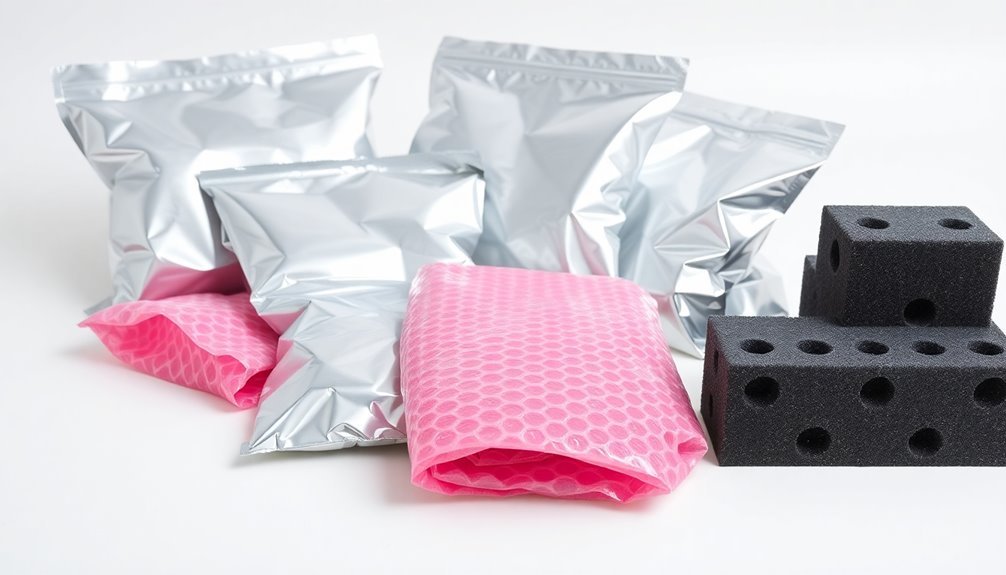



Leave a Reply